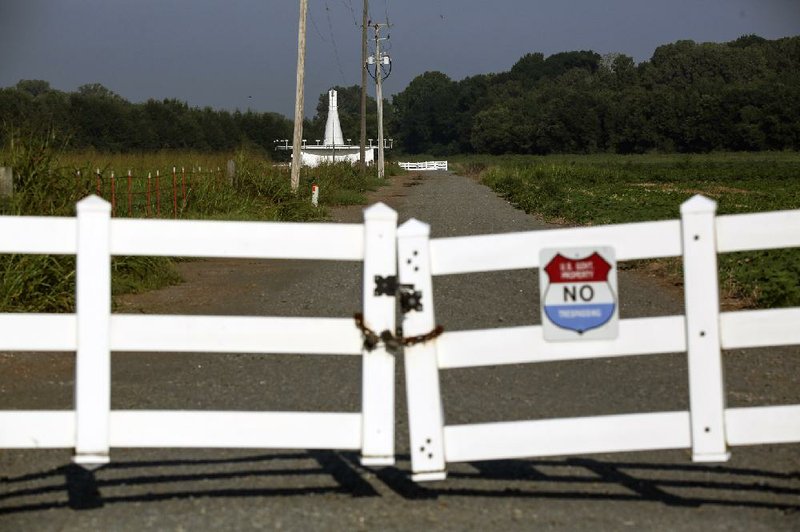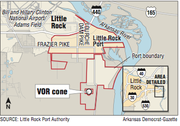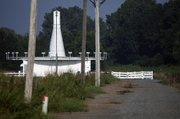An aging but still critical aid to navigation in the air is blocking the Little Rock Port from navigating its own future on land.
The Federal Aviation Administration, which operates and maintains the nation's network of VHF Omni Directional Radio Range stations -- known by the acronym VORs -- has agreed to take a look at moving the VOR station, a process that Bryan Day, executive director of the Little Rock Port Authority, acknowledged last week could take several years.
The station is in a remote area between the port and David D. Terry Lock and Dam and southeast of Bill and Hillary Clinton National Airport/Adams Field.
Dick Holbert, chairman and chief executive officer of Central Flying Service, said he remembers the station from when he flew with his dad, Claud Holbert, the founder of Central, in the 1950s. He began formal instruction at 16 and got his private pilot's license at 17 in 1960.
"It's been there for a long time," said Dick Holbert, chairman and chief executive officer of Central Flying Service.
LR station to stay
The VOR technology was developed after World War II, was widely installed in the 1950s and became the major navigation system for aircraft in the 1960s.
About 1,000 VOR stations with varying capabilities dot the United States, creating a series of VOR highways in the sky for pilots to fly cross country from VOR station to VOR station if their aircraft is equipped to use the navigation system.
In recent years, the technology has been supplanted by newer navigation systems based on satellites, popularly known as GPS.
The FAA, citing the $110 million annual cost to maintain the VOR navigation system, has embarked on a program to phase out about 30 percent of the VOR stations over the next few years. Enough will be kept, the agency said, to have a robust enough VOR system in place as a backup to satellite navigation.
The Little Rock VOR station will remain under the FAA plan.
Day is quick to point out, the port doesn't want to do anything to jeopardize it, either.
"It's critical for the navigation system," he said. "Whatever we end up doing, it's important we do no harm to anyone. We're not going to do anything to [affect] navigation for the little guy or the big guy."
But its location is problematic for a port running out of land to offer to the big companies that like its location with ready access to the river, rail lines and interstate. It is down to one 165-acre tract available for prospect tenants.
"The challenge for us is we're out of land," Day said. "Land acquisition is critical to our success, it's critical to our future and it's very important we pursue this."
The VOR station sits on 50 acres of land owned by the federal government. The port owns land surrounding that plot totaling nearly 400 acres.
But nothing associated with heavy manufacturing can be built within 5,000 feet of the VOR station. That building limitation ensures the VOR station signal can be emitted without being blocked.
"You can't do anything within a 1,000 feet of it except cut grass," Day said. "Between 1,000 and 2,000 feet, you can only build to 21 feet tall. Between 2,000 and 3,000 feet, you can build to 42 feet tall. Between 3,000 and 4,000 feet you can build to 84 feet."
Given that the standard warehouse is 50 feet tall, "you still can't do anything within 3,000 feet of the cone," he said. "We need the big heavy lifts, the big tall steam towers, we need to be able to offer that land to anybody who would want to come."
The port has few other options.
There are some parcels within the port that are available.
In March, the American subsidiary of the Chinese garment manufacturer, Suzhou Tianyuan Garments Co., announced its purchase of a 101,000-square foot building within the port for $1.85 million with plans to invest $20 million to equip the building and hire 400 full-time employees to produce clothing for Adidas.
Beyond that, pickings are slim for the port. To the east is the river, to the west is environmentally sensitive wetland and neighborhoods and to the north are neighborhoods and other development.
The land to the south is "high, dry, it's along the river," Day said. "Our only direction is south. But that cone is blocking our ability to expand."
Both sides willing
The FAA is open to looking at moving the VOR station, an intensive process to find a remote location free from interference to its carefully calibrated instruments but still within range of the airport with ready access to roads and electricity.
"These are typically located in a specific place for navigational precision, but that doesn't necessarily mean they cannot be relocated," said Lynn Lunsford, an agency spokesman. "Our engineers will determine if an alternate location will work."
Day said he recognizes the challenges.
"It's not easy, it's not inexpensive," he said. "There are a lot of challenges to having that conversation. But there's a willingness on both sides. Now we need to figure out how to do that."
Moving the station might also give the FAA an opportunity to upgrade the station as well, Day said. And there are possibilities short of moving the station. Some stations are elevated in place to be clear of obstacles.
He said it could take several years to make it happen, but the payoff will ensure the port's long-term viability.
"This first piece of land was bought in the early 1970s," he said. "They had the vision 50 years ago to come out and buy land. There was no interstate, the airport was small, just old gravel roads to get here. They had the vision to do that.
"We need to now have the vision 50 years from now when you and I are gone -- that the port is set up to accommodate growth. We have 4,000 people who work here and 40 businesses. Wouldn't it be nice in 20 to 30 years to have 8,000 people who worked here and 80 businesses?
"To do that, we have to have land. To do that, our only direction is to move south."
SundayMonday Business on 08/06/2017


